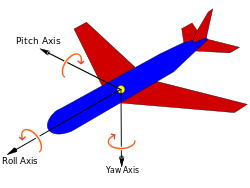
An aircraft in flight is free to rotate in three dimensions: yaw, nose left or right about an axis running up and down; pitch, nose up or down about an axis running from wing to wing; and roll, rotation about an axis running from nose to tail. The axes are alternatively designated as vertical, lateral (or transverse), and longitudinal respectively. These axes move with the vehicle and rotate relative to the Earth along with the craft. These definitions were analogously applied to spacecraft when the first crewed spacecraft were designed in the late 1950s.
These rotations are produced by torques (or moments) about the principal axes. On an aircraft, these are intentionally produced by means of moving control surfaces, which vary the distribution of the net aerodynamic force about the vehicle's center of gravity. Elevators (moving flaps on the horizontal tail) produce pitch, a rudder on the vertical tail produces yaw, and ailerons (flaps on the wings that move in opposing directions) produce roll. On a spacecraft, the movements are usually produced by a reaction control system consisting of small rocket thrusters used to apply asymmetrical thrust on the vehicle.